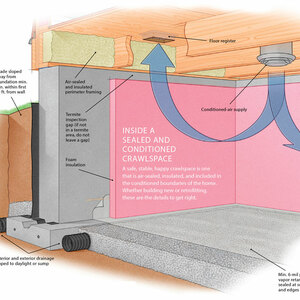So I finally caved in and agreed to ceramic tile our bathroom floor. Our house is a 1920’s bungalow, and I knew there was a mud bed under the layers of vinyl, but I didn’t realize what I was in for. I’ve never worked on an old bathroom floor.
Problem 1: I removed the vinyl and luan and I’m down to concrete. There are a couple of large cracks where there has been settling on either side of a post in the basement. This creates a slight hump. At a minimum I would need to level this before I could put down the 12″ tiles we already bought. If I did this the floor height in the bathroom would be almost a full inch higher than the hardwoods. Also, I haven’t used leveler before and don’t know if that is a suitable underlayment for the tile.
Problem 2: My original plan was to sledge out the mud, sister in full height joists (the originals are cut to allow for the mud), and put in a new subfloor. I guess I didn’t think this through enough. The mud, of course, runs under the tub, which I had no intention of removing. I didn’t intend to do a full-scale remodel of the bathroom – just put in tile.
Problem 3: Should I do anything about the hump? The post in the basement was clearly an addition after the house was built, which makes me believe there was sag there. Since it was added, however, the house has fallen a little off of either side and the post is holding up the center, creating this hump. It’s fairly minor, but a 12″ tile rocks to either side if you lay it on the crack.
As with everything else I have ever encountered with my old house, this looks like it is turning out to be a major project. Please let me have it with your ideas and opinions. I value the feedback I get from this site. You guys are a great resource.
Thanks!


















Replies
call a pro. if you want the job to last you need to cal a pro it will cost you but it will be done right not every thing can be done by a do it yourselfer save your self a lot of hassle and call a pro or forget about the tile and just put down linoleum
First, it's gonna be a major project......
Second, if you don't want to hassel with a major project, do as the Village Handyman advises and call a pro.
That said..........Tear out all the mud. You can stop were the tub starts, but plan to repack and voids with mud below the lip if the tub.
Next, figure out how to solve your floor joist framing problem. You can sister joists on and use these joist to level out the plane and then top it with 3/4" ply, then 1/4 underlayment.
But most important, get more detailed instruction from any number of how to books and perhaps cultivate a relationship with a sypathetic Pro.
Usually, when you encounter a full mud bed in a bathroom, there is ceramic tile on it. Oh, well.
I don't think your joists have been cut down to accomodate the thickness of the mud bed. What I think you'll find when you break out the bed is that the top of the subfloor of 1 bys is flush with or even slightly below the top of the joists. They will be sitting on ledgers nailed to both sides of each joist. Because the subfloor is not on top of the joists you get your first 3/4"+ of mud depth. Then there is the thickness of the finished floor, another 3/4". So that gives you a mud base, usually with tile, approximately 1 1/2"+ thick, that is even with the finished wood floors.
Break out the mud base, level the joists, paring the hump out, shimming or sistering where needed, screw down a couple of layers of plywood - at least an inch, more if possible, screw and thinset 1/4" cement backer, lay tile. The goal is to have as stiff a floor as possible before you lay the tile.
CD, as you well know, we are trying to give you advice based upon your description alone...a tough thing do. You didn't say what size of an area you were dealing with,or what the general condition of the rest of the room is in,or what your needs or expections as to quality and durability are.
The folks that prowl this board will expect you to go to the highest level of quality. In keeping with that, the advice to have a pro look at the job is probably the most suitable.
However...........If this were my home....and the space was small.......and the rest of the room looked 'lived in'....I would either grind the hump down a little,or float a little more modified thinset where needed to build up,or my first thought:Center a grout line along the hump and set the tiles to either side of the hump.
Luck, jw
what the heck
was I thinking?
Ralph - thanks to your comment I looked a little closer in the basement. You are correct about the joists. They weren't cut after all. The biggest good news is that the mud doesn't appear to run under the tub. I can't believe I missed either of these the first time around. I'm now thinking I can go ahead and break out the mud, leave the tub undisturbed, plane a little off the high joist, replace the subfloor, add backer board and tile.
More details for Heck - it's a small bathroom. The floor space is about 5x6. The house definitely has that "lived in" feel, but I do usually try to do the right thing and go with quality - both in workmanship and materials. In my opinion, the right thing in this case is to get rid of the cracked mud bed.
Any other pitfalls you see coming?
Sounds like you're on the right track....ain't this place amazing?what the heck was I thinking?
Okay - bathroom help, part II, please. I almost started a new thread, but decided some folks may want to read the history.
Yesterday I jack-hammered the mud out of the bathroom, removed all of the old abandoned pipes, sistered on new nailing surfaces and cut a new 3/4" plywood floor. I have not nailed it down yet.
My new question is about height and levelness. As I'm sure you are aware, virtually nothing is ever level or square in an old house. The philosophy I have taken with most things is to build it to the house, not to the level. There are exceptions, but often things don't look right with the room if they are built perfectly level in a house that has settled over the years. I mentioned earlier that there were a couple of joists that were higher than the rest because there is a post in the basement under them. The other joists have sunk a little on either side, creating a high spot, which cracked the original mud bed and made it difficult to add tile. My solution was to plane down the high joists slightly. I did this, laying a straight edge across three at a time until they were all close enough to the same level to lay floor and tile. The problem is that the whole floor seems to drop to one side. With the plywood down, I have just under 1.5" to get to the old floor level on one side, and just over 2" to get to the same point on the other side.
I was planning to use 1/2" Denshield under the tile, plus the 1/4" tile, so I will only be adding 3/4" plus thinset. That still leaves me a large gap, plus the fact that the floor seems to fall in the space. Should I leave the slight angle and add another layer of 3/4"? Should I rip strips to add to the tops of the joists? How would you all handle this?
By the way, any reason I shouldn't use Denshield? Seems like a good product and easy to work.
I wouldn't use a gypsum product in a wet environment if I had the choice under any circumstances. There's a lot of debate amongst my friends over at JB forums but there are far more "against" than "for" denshield b/c of long term performance concerns. It is nice to work with though.
I just finished a bath with similar issues in my house. I chose to live with the floor out of level, b/c the room would have been the only level room on that side of the house. Had I done it, though, gluing/sistering would have been the method.
If I understand you correctly, leveling the floor by sistering would make your tub look out of level (unless you've ripped that out too?). Gluing and sistering would be the best choice if the subfloor is already ripped out. Some pics might help. Also check out http://www.johnbridge.com and visit the DIY forum there.
Good luck.
Brian_____________________________HomeBase________ Kitchen & Bath Builders, LLC
Brian Roberts, Manager
Thanks for the response, Brian. Actually, the tub and wall tile are close to level - it's the floor that is now sloping and it is obvious next to the grout lines and tub bottom. The gap under the tile and tub gains about an inch and a quarter in just over 6 feet. It's very noticeable.
I'm a little worried about sistering in pieces that are just carrying weight with nails. They won't have anything to rest on to carry the load. Is this okay?
You have three ways to go, depending on your budget, your skills, and the quality of job you want to do. The three choices are the correct way, the cheap way, and the easy way.
The correct way is a traditional mud bed. It was there long before you owned the place, and remains the absolutely best tile setting bed. It is also very inexpensive. Take the floor down to the planks, staple 6 mil poly onto the floor, then nail 3.5 diamond lathe to the floor. Buy some pre-mixed drypack deck mud ($5 a bag) and using 3/4" conduit (leveled in mud) as rails and a 1x4 as a screed, float your mud bed. It will be dead flat and level. Total cost will be about $100.
The cheap way is to use backerboard, a typical DIY method. You will need to install them over plywood, so using shims try to level the plywood. Good luck, you will need it. Top the ply with unmodified thinset and backer board and tile away. Total cost is about $60 and you need no skill and only a few hand tools. The floor will not be flat, nor level, and your tile may crack.
The easy way is to prepare the floor for mud as stated above and instead of mud, use a Self Leveling Compound. This stuff is outrageously expensive at about $35 a bag, and you will need about 10 bags, depending on the bag and the size of your hump. It is also labor intensive to apply, because you cannot pour it in batches, as it sets up in about 5 minutes! You will need 3 guys with buckets and drills to mix it up all at once and dump it in place. Gently spread it around and leave it alone. It will seek its own level. It will not be perfectly flat nor level, but pretty darn close, and can be fixed using a grinder or tile patching compound. Total cost will be over $500.
Your choice. . . . .
Regards,
Boris
"Sir, I may be drunk, but you're crazy, and I'll be sober tomorrow" -- WC Fields, "Its a Gift" 1927